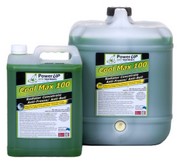COOL MAX 100
Description
This is a general purpose ready to use glycol based treatment for automotive cooling systems. Freezing point is -35 degrees C approx at 50% dilution and -15 degrees C at 35% dilution. Replace at 24 month / 60,000 km intervals. May be replaced more frequently depending on engine and driving conditions. Top up radiator as required to avoid rundown in concentration. This product contains a pH-buffered blend of additives known to reduce the corrosion of steel, cast iron, aluminium alloy, brass, copper and solder.
This product exceeds the performance requirements of the following standards when assessed in hard water and is made to General Motors Specification HN 2043
* ASTM D1384 ” Corrosion Test for Engine Coolants in Glassware.”
* ASTM D4340 “Corrosion of Cast Aluminium Alloys in Engine Coolants Under Heat Rejecting Conditions.”
* ASTM D2570 “Simulated Service Corrosion Test for Engine Coolants.”
* ASTM D2809 “Cavitation Corrosion and Erosion Corrosion Characteristics of Aluminium Pumps With Engine Coolants.”
* Australian/New Zealand Standard 2108.1:1997 “Engine Coolants Type A and Type B for Engine Cooling Systems.”
This product will not reverse pre-existing corrosion problems, and should not be used in conflict with engine manufacturer’s recommendations.
Properties
- Specific Gravity : 1.12 – 1.13
- Reserve Alkalinity (ASTM D1121) : > 10.0
- Freezing Point (1:2 by volume) : -15oC approx
- (1:1 by volume) : -35oC approx
- (2:1 by volume) : -40oC approx
- Boiling Point (1:2 by volume) : 120oC approx
- (1:1 by volume) : 125oC approx
- (2:1 by volume) : 130oC approx
- Glycol Content : 980 ml / litre
- pH (1:2 by volume) : 10.5 Approx.
- Formulation Type : GMH HN2043
- Flammability Class : Non-flammable (Combustible)
Test Results
Glassware Corrosion : ASTM D 1384
| Maximum Allowable Mass Change (mg) | Anti-freeze /Anti-boil | ||||
| AS 2108 | ASTM D3306 | BS 6560 | GM 1825M | Avge | |
| Copper | 10 | 10 | 10 | 10 | +1.4 |
| Solder | 15 | 30 | 15 | 20 | -1.1 |
| Brass | 10 | 10 | 10 | 10 | -0.2 |
| Steel | 10 | 10 | 10 | 10 | -0.4 |
| Cast Iron | 10 | 10 | 10 | 10 | +0.9 |
| Cast Aluminium | 15 | 30 | 15 | 20 | +0.1 |
Test performed at 1:2 (v/v) in hard water.
Corrosion of Heat Stressed Alloy : ASTM D 4340
Heat transfer corrosion rate = 0.077 mg/cm2/week
Allowable corrosion rate = 1.0 mg/cm2/week
Test performed at 1:3 (v/v) in hard water.
Simulated Service : ASTM D 2570
| Maximum Allowable Mass Change (mg) | Anti-freeze /Anti-boil | ||
| AS 2108 | ASTM D3306 | Avge | |
| Copper | 20 | 20 | -0.3 |
| Solder | 30 | 60 | -1.5 |
| Brass | 20 | 20 | -0.4 |
| Steel | 20 | 20 | -2.4 |
| Cast Iron | 20 | 20 | -7.9 |
| Cast Aluminium | 30 | 60 | -2.5 |
Test performed at 44% (v/v) in hard water.
Cavitation Corrosion : ASTM D 2809
Corrosion Rating 9
No cavitation damage evident.
Use
First read the label on the container and the vehicle manual. When engine and cooling system are cool, drain existing coolant (including the heater) as per the vehicle owners’ manual or by disconnecting lower radiator hose. After draining, flush system (including heater core) thoroughly with Cool Max 100 and reconnect hoses, drain plugs etc. In a clean vessel mix Cool Max 100 at 35-50% with clean water and slowly add sufficiently to fill the cooling system. Refer to the vehicle owners manual for the volume needed. To avoid possible incompatibility problems, do not mix with other coolant formulations.
Check level after the engine has reached operating temperature and allowed to cool again. Top up with prediluted Cool Max 100 if necessary. Any spillage on paintwork should be flushed off with water. Used coolant may be harmful to the environment (due to the extraction of heavy metals from the engine): contact regulatory authorities on appropriate methods of disposal
Safety
This product contains ethylene glycol and is poisonous if swallowed. Read Material Safety Data Sheet before use. Avoid contact with the skin and eyes. Keep out of reach of children.

